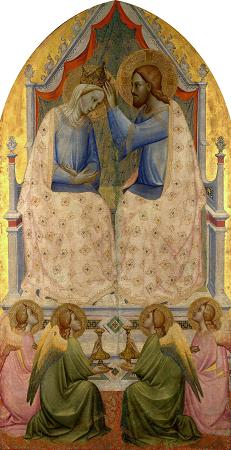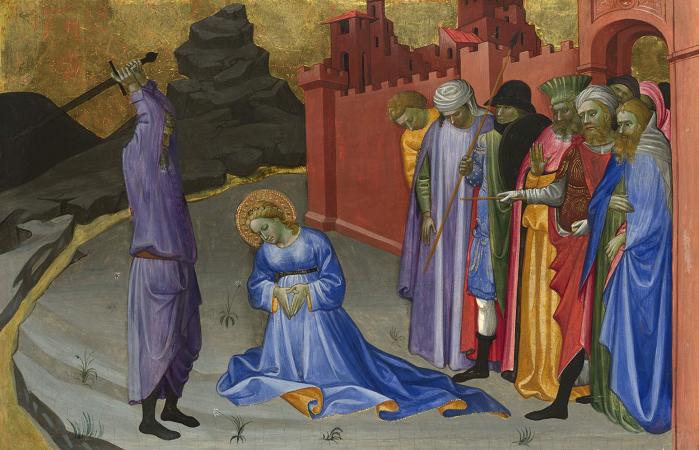National Gallery. The National Gallery is an art museum in Trafalgar Square, London, housing a vast collection of Western European paintings from the 13th to the 19th centuries. Founded in 1824, its collection began with 38 paintings purchased from the private collection of John Julius Angerstein. From the 14th century, the collection has two versions of Coronation of Virgin, one by Giusto Menabuoi (c1367) and another by Agnolo Gaddi (c1380). Famous painting from the 15th century include the Arnolfini Marriage by Jan van Eyck (1434) and Saint George and Dragon by Paolo Uccello (c1460). From the 16th and 17th centuries there is the Ambassadors by Hans Holbein the Younger (1533) and Supper at Emmaus by Caravaggio (1600). Thomas Gainsborough's Robert Andrews and Wife (c1750) and Morning Walk (c1785) were painted in the 18th century. 19th contury works include Hay Wain (1821) by John Constable, The Fighting Temeraire (1839) by J.M.W. Turner and Sunflowers (1888) by Vincent van Gogh. Beyond its art collection, the museum acts as a cultural and educational center, offering events, workshops, and lectures. The Gallery is an exempt charity, and a non-departmental public body of the Department for Culture, Media and Sport. Its collection belongs to the government on behalf of the British public, and entry to the main collection is free of charge. It is among the most visited art museums in the world, after the Louvre, the British Museum, and the Metropolitan Museum of Art. Unlike comparable museums in continental Europe, the National Gallery was not formed by nationalising an existing royal or princely art collection. It came into being when the British government bought 38 paintings from the heirs of John Julius Angerstein in 1824. After that initial purchase the Gallery was shaped mainly by its early directors, notably Sir Charles Lock Eastlake, and by private donations, which today account for two-thirds of the collection. The collection is small compared with many European national galleries, but encyclopaedic in scope; most major developments in Western painting from Giotto to Cezanne are represented with important works. It used to be claimed that this was one of the few national galleries that had all its works on permanent exhibition, but this is no longer the case. The present building, the third to house the National Gallery, was designed by William Wilkins from 1832 to 1838. Only the facade onto Trafalgar Square remains essentially unchanged from this time, as the building has been expanded piecemeal throughout its history. Wilkins's building was often criticised for the perceived weaknesses of its design and for its lack of space; the latter problem led to the establishment of the Tate Gallery for British art in 1897. The Sainsbury Wing, an extension to the west by Robert Venturi and Denise Scott Brown, is a notable example of Postmodernist architecture in Britain. The current Director of the National Gallery is Gabriele Finaldi. The late 18th century saw the nationalisation of royal or princely art collections across mainland Europe. The Bavarian royal collection opened to the public in 1779, that of the Medici in Florence around 1789, and the Museum Francais at the Louvre was formed out of the former French royal collection in 1793. Great Britain, however, did not emulate the continental model, and the British Royal Collection remains in the sovereign's possession today. In 1777 the British government had the opportunity to buy an art collection of international stature, when the descendants of Sir Robert Walpole put his collection up for sale. The MP John Wilkes argued for the government to buy this invaluable treasure and suggested that it be housed in a noble gallery.
more...














